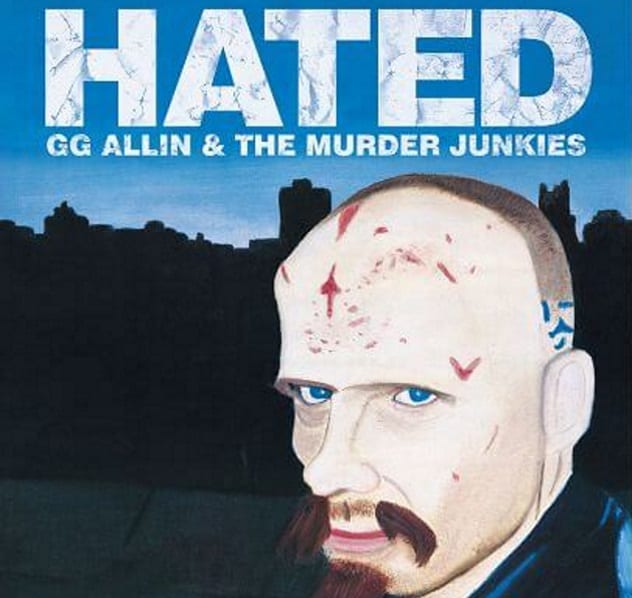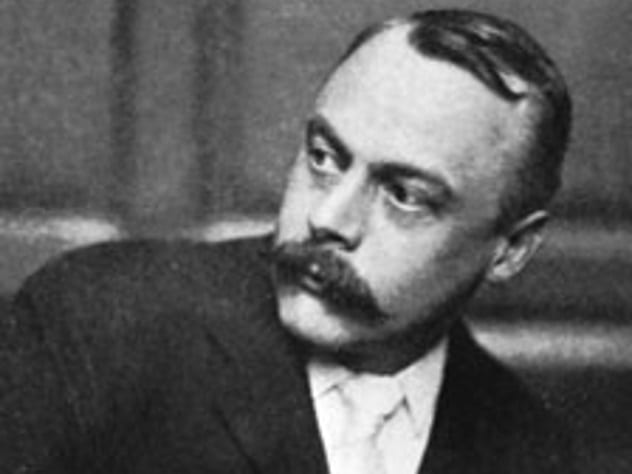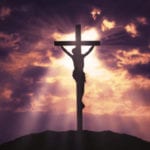 Our World
Our World  Our World
Our World  Movies and TV
Movies and TV The 10 Coolest Stars to Set Sail on The Love Boat
 History
History 10 Things You Didn’t Know About the American National Anthem
 Technology
Technology Top 10 Everyday Tech Buzzwords That Hide a Darker Past
 Humans
Humans 10 Everyday Human Behaviors That Are Actually Survival Instincts
 Animals
Animals 10 Animals That Humiliated and Harmed Historical Leaders
 History
History 10 Most Influential Protests in Modern History
 Creepy
Creepy 10 More Representations of Death from Myth, Legend, and Folktale
 Technology
Technology 10 Scientific Breakthroughs of 2025 That’ll Change Everything
 Our World
Our World 10 Ways Icelandic Culture Makes Other Countries Look Boring
 Our World
Our World 10 Ways Your Christmas Tree Is More Lit Than You Think
 Movies and TV
Movies and TV The 10 Coolest Stars to Set Sail on The Love Boat
 History
History 10 Things You Didn’t Know About the American National Anthem
Who's Behind Listverse?

Jamie Frater
Head Editor
Jamie founded Listverse due to an insatiable desire to share fascinating, obscure, and bizarre facts. He has been a guest speaker on numerous national radio and television stations and is a five time published author.
More About Us Technology
Technology Top 10 Everyday Tech Buzzwords That Hide a Darker Past
 Humans
Humans 10 Everyday Human Behaviors That Are Actually Survival Instincts
 Animals
Animals 10 Animals That Humiliated and Harmed Historical Leaders
 History
History 10 Most Influential Protests in Modern History
 Creepy
Creepy 10 More Representations of Death from Myth, Legend, and Folktale
 Technology
Technology 10 Scientific Breakthroughs of 2025 That’ll Change Everything
 Our World
Our World 10 Ways Icelandic Culture Makes Other Countries Look Boring
10 Influential Movies With Dark And Surprising Origins
There is a common belief that movies work as escapism from the struggles of real life. Despite the omnipresent scenes of sex and violence, movies are somehow seen as separate from the burdens of life.
Movies, however, do not exist in a vacuum. Macabre troubles affect filmmakers just like anyone else; they just use their movies to cope. Death constantly pops up in projections because death constantly appears in life. The following are just ten examples.
10 A Peeping Tom Launched Science Fiction Movies
More than 90 years after its release, art of all forms is still shaped by 1927’s Metropolis. Its status as the first science fiction movie of note and its unprecedented production methods are apparently not enough of a legacy. Its continued influence is felt in all of the films that steal iconography from Metropolis. Blade Runner and Tim Burton’s Batman borrow Fritz Lang’s steely skyline of an Art Deco city. Even the movies that rip off Metropolis are iconic. Maria the Maschinenmensch’s robotic frame was a direct visual inspiration for Star Wars’s C-3PO. Madonna and Lady Gaga have similarly copied Maria for their wardrobes. Many forces went into shaping the imagery of Metropolis, but most of the great shots come from director Fritz Lang’s monocled eye for details.
Lang may have directed one of the greatest science fiction movies of all time, but he was not a lifelong fan of the genre. Born into relatively wealthy status, he was discouraged from reading pulp fiction. Justifiably or not, science fiction in the early 1900s was considered literary garbage. The genre was simply unavailable, even if Lang wanted to read it. Lang might not have been interested in sci-fi, but he was certainly interested in watching his house servant undress.[1] When Lang was a teenager, he snuck into his maid’s bedroom to catch a glimpse of her disrobing. He never did get a chance to see her. Instead, he found a stack of penny dreadfuls, including The Phantom Robber. Trying to kill time, he started reading the cheap novels. Upon discovering Lang with the book, his father slapped him in the face and took it from him. Despite the pressure from his dad, Lang’s fascination with science fiction was born.
9 A Serial Killer And A Shock Rocker Paved The Way For The Hangover

Along with Judd Apatow and Adam McKay, Todd Phillips led a movement in 2000s comedy known as “the Frat Pack.” These directors’ sophomoric movies and focus on improvisation became the defining language of Hollywood comedies in the 2000s. The highest-grossing film in this movement was Todd Phillips’s The Hangover. Nobody would accuse a movie with Mike Tyson air-drumming to Phil Collins of being anything more than fun. Yet, that movie would not have existed without the early contributions of John Wayne Gacy.
Long before the Hangover franchise, Todd Phillips was just a struggling student in NYU’s film school. He dropped out to make Hated, a guerilla documentary on controversial musician GG Allin. The notorious punk singer made his reputation by smearing himself with feces and blood onstage. Allin’s concerts were infamous for assaults and violence. Perhaps it is not surprising, then, that one of the artist’s biggest fans was serial killer John Wayne Gacy. Gacy had already been convicted of killing more than 30 teenage boys when Allin approached him with a business deal. Gacy would paint a portrait of Allin, and Phillips would sell the copies. The plan worked. The paintings sales practically financed Hated single-handedly.[2] Shortly before Hated was released, Allin died. In his honor, Hated received a limited theatrical run. The movie became the highest-grossing student film of all time.
Hated ’s financial and critical success allowed Phillips to make another documentary. Not far removed from GG Allin’s vulgar sadomasochism, the next film was about college fraternities. Frat House, though less acclaimed than Hated, was an important step in Todd Philips’s career. At a screening of Frat House at Sundance, Phillips met director Ivan Reitman. Reitman hired Phillips to come on board as a writer for a film he was working on called Old School. Old School helped Phillips land a writing gig on Borat, which got him nominated for an Oscar. Though nowhere as bad as killing as dozens of children, inspiring millions of annoying Borat impressions is a mixed legacy of its own.
8 The Shocking Rape And Murder Behind The First Horror Movie
The German Expressionists strike again. Just as Metropolis holds the debatable distinction as the first great science fiction film, The Cabinet of Dr. Caligari is generally considered the first great horror movie. For any introductory film student, The Cabinet of Dr. Caligari is essential viewing. The historical legacy of Dr. Caligari is hard to overstate. Some consider it the most discussed film of all time. Evoking a shadowy dream world, the macabre mise-en-scene influenced all horror movies to come. Scriptwriter Hans Janowitz knew from experience how terrifying shadows could be.
In 1913, Janowitz was walking through a fair. Along the way, a young lady caught his eye. He followed her for a while, hoping to strike up an encounter. Meandering through the tents, he lost her. Walking back, he heard a noise. There seemed to be sinister laughter among the trees. A man appeared in the shadows, only to quickly disappear moments later. Equal parts scared and disappointed, Janowitz left for home.
The next morning, he read of a young woman named Gertrude who had been raped and murdered at the fair. Janowitz became convinced that this was the girl he met the night before. Of course, it is impossible to know if any real connection existed between the two women. Janowitz became obsessed. He routinely returned to the crime scene out of guilt. He even attended Gertrude’s funeral.[3] While there, he had a feeling that the killer was also present, watching in the darkness. Seven years later, Janowitz manifested the secret presence of death on-screen with his immortal Cesare.
7 Getting Into The Holiday Spirit For Texas Chainsaw Massacre
It should be no surprise that the person who came up with The Texas Chainsaw Massacre might have had some weird ideas. The weirder part is that this tale of young coeds being picked off by a family of cannibalistic murderers was hatched because of the Christmas season.
More annoyed than jolly, Tobe Hooper hated Christmas shopping. Anyone who has screamed in a mall parking lot over someone stealing the last spot understands what Tobe was thinking. One stop on his Christmas shopping trip was the hardware store. Hooper was growing impatient with the large crowd blocking his way. In his desperation, he figured he could just pick up a nearby chainsaw off the rack and chase the people out of the store.[4] Obviously, he did not do it. In that moment, he saw the whole movie in his head. When he got home, he started writing.
With the perfect weapon, all he needed was an appropriate villain. Like the other great precursor to the slasher genre, Psycho, Hooper drew upon the crimes of Wisconsin murderer Ed Gein as a model. The gritty realism of Gein’s story shaped the film. For Leatherface’s defining look, Hooper again drew upon his own life for inspiration. One of Hooper’s friends was a doctor. The doctor confided to Hooper that when he was a premed student, he had access to cadavers to study. Around Halloween time, the doctor went into the morgue and cut off a corpse’s face. When the holiday rolled around, he used the skin for the mask of his costume. In 1974, Leatherface would do the same thing, ushering in the golden age of the slasher movies.
6 The Fraud That Shaped Every Movie Ending
Unlike the other entries on this list, Rasputin and the Empress is not considered a beloved classic. Despite the incredible star power of Hollywood Legends Ethel, Lionel, and John Barrymore, the movie is generally forgotten by the public. Yet, moviegoers everywhere still see the consequences of the film every time they go to the theater. Cinephiles patient enough to stay through the credits will eventually see some variation of the phrase, “This is a work of fiction. Any similarity to actual persons, living or dead, or actual events, is purely coincidental.”[5] As boring as credits can be, few would suspect that the mundane language of this legal rider only exists because of murder and a man wrongly accused of rape.
In 1916, Prince Felix Yusupov was part of the group of Russian aristocrats who organized Grigori Rasputin’s assassination. Furious over the mad monk’s growing influence on the tsar, Yusupov poisoned Rasputin’s meal. A shooting and drowning in the river were thrown in the mix to make sure the job was done. For his role in the murder, Yusupov was exiled to Paris.
When the movie debuted years later, he sued for libel. He didn’t sue that his character was defamed because the film depicted him as a murderer. Instead, he sued over a scene where Rasputin hypnotizes and rapes his assassin’s wife. Because the assassin was Yusupov’s on-screen equivalent, that meant the rape victim’s cinematic equal was Yusupov’s wife, Irina. According to Yusupov, the implication was that the rape lessened Irina’s social value. MGM insisted the scene was based on true events, even though Irina never met Rasputin. Yusupov won the lawsuit. MGM had to pay $25,000, more than the movie cost to make. To ensure that they never had to pay out anything like this again, they slapped the phrase “this is a work of fiction” on every movie since.
5 Incest And Rebel Without A Cause
The fascinating and heartbreaking Rebel Without a Cause should never have existed. In 1944, Dr. Robert Linder wrote a case study about his patient Harold, an inmate at the Lewisburg Federal Penitentiary. Dr. Linder treated Harold with hypnosis to see if he could end Harold’s criminal streak. The final product was a droll scientific analysis, hardly ready for the big screen. Multiple script doctors were brought in along the way, including Theodor Geisel, who would soon write under the more famous pseudonym Dr. Seuss. Geisel quit when it appeared that none of the producers had even read the book. The movie sat dormant for years. In 1954, the project, in chaos, needed a deft hand to rescue it. Director Nicholas Ray provided just that, but he almost assuredly would have preferred to have never gotten involved in the first place.
In June 1951, Nicholas Ray walked in on his wife, Gloria Grahame, in bed with another man.[6] This would have been bad enough for most people. To make matters worse, the person she was with was only 13 years old. To top it off, it was Ray’s own son from his previous marriage, Anthony, who’d returned home from military school. (Later, in 1960, the whole sordid affair somehow became even weirder when Gloria married Anthony.) Needless to say, Ray was deeply upset. He tried to understand how his son could do something like this. He started reading books on the thoughts of the adolescent mind. He eventually discovered the long-forgotten script and rushed its production. On set, he said that he took the movie to see why he had failed as a father.
When Nicholas Ray came along, he made significant changes to the movie. With Ray’s recent events certainly still weighing on his mind, many people have picked up on the film’s subtle hints of incest between Natalie Wood’s Judy and her father. Ray made an even bolder sexual decision. From a historical perspective, Ray’s choice to have Sal Mineo portray Plato as gay was revolutionary. Plato became the first mainstream gay teenager on film. Ray’s main contribution was portraying James Dean’s Jim Stark as sympathetic. Dean’s last great role before his early death, Jim Stark, was essential in ensuring both the legend of James Dean and the model for teenagers everywhere.
4 Animal House Was Originally About Charles Manson
Charles Manson never made it into Hollywood. He tried repeatedly but was rightfully dismissed as a creepy weirdo. He did leave an impact, of course. The murders carried out on August 8, 1969, snuffed out burgeoning stars like Sharon Tate, Jay Sebring, and Wojciech Frykowski far too early. Many movies have drawn upon the murders for inspiration, including Quentin Tarantino’s latest. However, the real legacy would be how the gruesome slayings created one of the most enduring comedies of all time.
Doug Kenney was very eccentric. Co-founder and head writer for National Lampoon magazine, Kenney had liberty to pitch any idea he wanted. In his personal life, however, Kenney was struggling. He had been going through a divorce after his rampant adultery, left works for months at a time, and became a chronic drug abuser. Matty Simmons, creative head of National Lampoon, thought that making a movie would give Doug some purpose in this period. Kenney and another National Lampoon writer, Harold Ramis, took that freedom and ran with it. When they returned, they handed Simmons a zonked-out spec script called “Laser Orgy Girls.”[7]
The story followed Manson’s antics while he was in high school. In the script, the hypnotic cult leader has multiple gang rapes along the way in his quest to meet aliens in the desert. Simmons objected to the idea. He thought that gang rape was inappropriate for high school but would be fine in college. With not a lot of time, Ramis and Kenney invited their friend Chris Miller onboard. The three just swapped their craziest college stories until something landed. Many of those stories later appeared as scenes or elements of the movie, like the horse dying in the office or a frat brother named “Pinto.”
Animal House was a huge success. For a while, it was the highest-grossing comedy in film history. Unprecedented popularity made Kenney even more neurotic. He fell back into drug use. Two years after the release, Kenney committed suicide by jumping off a cliff in Hawaii. He was 33.
3 Mr. Toad’s Tragic Ride

The happiest place on Earth may be Disney World, but it certainly wasn’t Disney’s studios. In 1941, the Disney writers went on strike. All movies except an adaption of Kenneth Grahame’s 1908 book Wind in the Willows stalled production. Walt Disney hated the book and thought it was a waste of money. Disney did not have a lot of money to waste.
Part of the studio system, Disney in the 1940s was in financial trouble. A mix of internal struggles and wartime rationing hurt the company, so much so that there were talks of getting rid of the animation wing entirely. Facing economic and studio pressure, animators whittled the film down to just 25 minutes. It was shelved for years, until it was haphazardly slapped onto a retelling of Washington Irving’s The Legend of Sleepy Hallow. Partially due to its turbulent production process, The Adventures of Ichabod and Mr. Toad was released in 1949 to tepid response. Disney had to change.
The movie marked the end of the studio package era of Disney. In the 1950s, Disney focused more on live-action movies and less on animation. Yet, the character of Mr. Toad is still associated with Disney in the public consciousness today, thanks to the Disneyland attraction Mr. Toad’s Wild Ride. Operating since the park’s debut in 1955, passengers follow along with Mr. Toad as he recklessly drives a vehicle, narrowly avoiding hitting people. It is cruelly ironic that Mr. Toad’s inspiration did not have the same luck.
Mr. Toad and the rest of the Wind in the Willows characters came out of bedtime stories Kenneth Grahame (pictured above) told his son, Alastair. Mr. Toad, in particular, was directly modeled after Alastair. Mr. Toad was spoiled and used his wealth foolishly. Kenneth hoped Alastair would pick up on the similarities and change his ways. He did not. The relationship between the two only got worse. Growing tired of Kenneth’s tales, Alastair simply ignored his father. As a teenager, his rebellions grew darker. He requested that his dad call him “Robinson” instead of Alastair. Robinson was the name of a man who tried to kill Kenneth for working at a bank. Not content with simply emotional harm, Alastair repeatedly put himself in physical pain. Torturing both drivers and his dad, Alastair had a hobby of running in front of cars to see if they would stop.[8] He eventually graduated to lying in front of trains. The trains did not stop. One ran over him as he purposely lay on a railroad track, decapitating him instantly. He was 20.
2 The Murder Behind The Iron Giant
Over the past two decades, Brad Bird has helmed multiple critically acclaimed blockbusters like The Incredibles, Ratatouille, and Mission: Impossible – Ghost Protocol. Yet, his most celebrated movie is also his least successful. Criminally ignored upon its release, The Iron Giant took years to find an audience. Those who discovered it were treated to a beautiful allegorical tale of a boy and his Earth-destroying robot. Disturbing the alleged tranquility of its 1950s setting, The Iron Giant serves as a powerful examination of nuclear anxiety, militarization, and violence in general. Pretty heavy themes for a kids’ movie, but Brad Bird was on a personal crusade. He understood all too well how violence can ruin lives.
The attempt to rationalize violence came out of a family tragedy. Before he was set to meet with Warner Brothers, Brad Bird’s sister was shot by her estranged husband. The murder forced Bird to examine how one could commit such a meaningless act. He asked himself the philosophical question, “What if a gun had a soul?”[9] This thought changed the whole direction of the source material. The robot in Ted Hughes’s original book, The Iron Man, is a Christlike figure who sacrifices himself for humanity. Brad Bird’s reinterpretation depicts the titular robot not as someone who suffers but as someone who could cause suffering if they wanted. The emotional resonance appears in the movie in a much smaller way, too. In her honor, the closing credits simply read, “For Susan.”
1 The Cannibal Who Made The First Zombie Movie
There’s an old expression saying to write what you know. Therefore, it almost makes sense that the person who started the zombie trend in America also liked to consume human flesh. William Seabrook was a man of many titles: explorer, writer, and, shockingly, cannibal. Seabrook first expressed his obsession with cannibalism in his book Jungle Ways. Set in the Ivory Coast, Jungle Ways interweaves Seabrook’s travels with mysticism. Holding a very myopic view of the locals, he repeatedly asked tribes if they practiced cannibalism. None did. When he adamantly asked for human flesh, they feed him baboon instead. Unpleased with the substitute, his search for flesh took him to France. Thanks to some backroom dealings with a morgue operator, he secured a human thigh. He threw a party to celebrate his new meal. In the middle of the celebration, he took out the thigh and ate it in front of everybody.
This was not Seabrook’s first encounter with a corpse. Before Jungle Ways, he wrote about watching decomposing bodies in The Magic Island. Seabrook’s book details Haitian voodoo practices. One particular account about a rumor of people coming out of their graves and the village that had to put them down stayed with Seabrook. He watched as the disfigured bodies of a long-deceased couple were desecrated.
Writing about these trips changed the movie industry. The Magic Island, an immediate best seller, helped bring the word “zombie” into the popular lexicon. “Zombie” became a fixture of American horror when The Magic Island was adapted into the 1932 movie White Zombie.[10] Focused more on voodoo magic than screaming hordes, White Zombie is nevertheless an important step in the creation of our contemporary notion of the zombie.
Appropriate for a founder of horror, Seabrook’s life was tragically dark and surreal. He worked alongside famed occultist Aleister Crowley. Interested in sadomasochism, Seabrook chained women up in his basement for days at a time. In the last years of his life, he used his alleged magical powers to place a death hex on Hitler. His embrace of the bizarre left him ostracized by the rest of New York’s literary circles. Ashamed by the criticism, he became depressed. Increasingly unable to handle the judgment, he turned to drugs and alcohol. In 1945, he committed suicide by purposely overdosing. He was 61.
Nate Yungman likes movies. He does not like death. You can follow him on Twitter @nateyungman. If you want to send a comment or question, e-mail him at [email protected].
Read about more films with surprising backstories on 10 Frightening Movies Based On True Stories and 10 Disney Movies With Horrific Origins.








